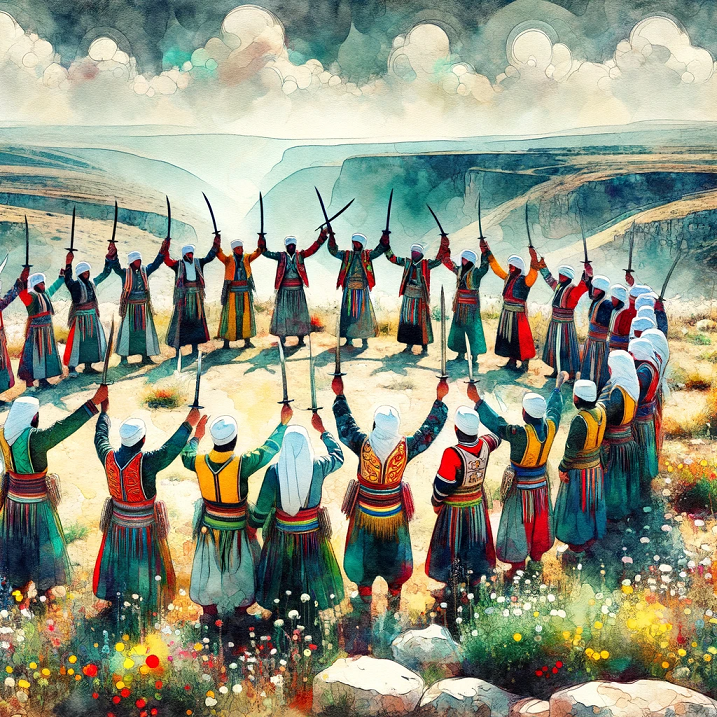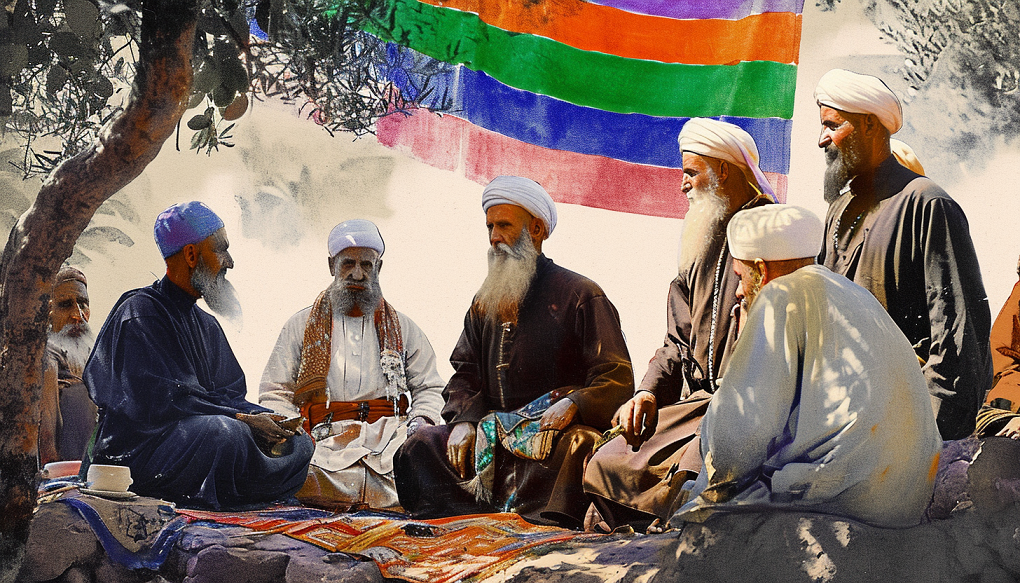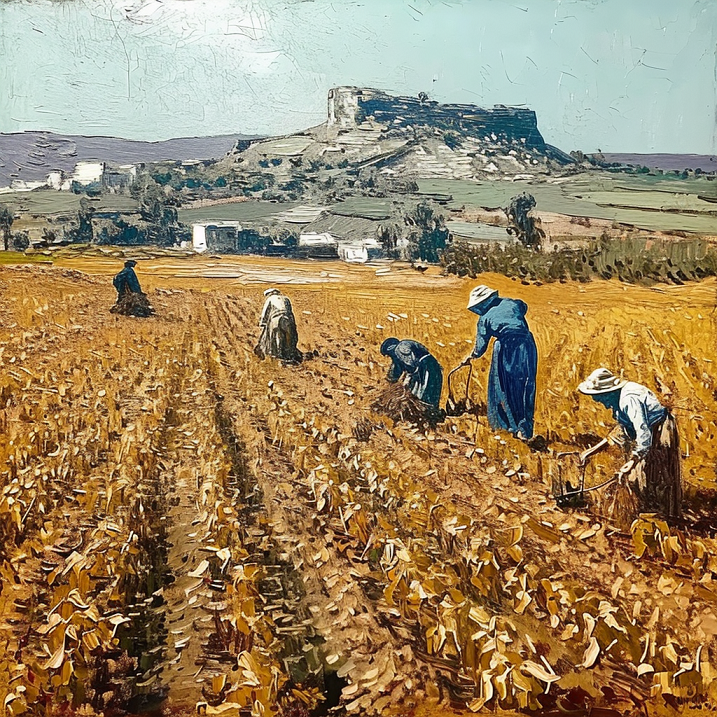In Gertrude Bell’s chronicles of the Syrian Jebel Druze, she delves into the historical significance of Salkhad or Salcah, an ancient city once ruled by King Og of biblical fame. This fortified city has a rich history dating back to the dawn of civilization. Situated at the base of a small volcano, Salcah’s most remarkable feature is the ruined fortress that stands atop this natural wonder. Over the centuries, this fortress, along with its predecessors in the crater, served as a critical outpost guarding the Hauran Mountains against the encroaching desert and the earliest marauders.
Key Takeaways:
- Salkhad served as a starting point for the Roman road into the desert and the caravan track to Nejd.
- Turkish government officials in the Mountain maintained a delicate balance of authority, relying on Druze zaptiehs for security.
- Despite limited Turkish soldiers in the region, Druze-owned steam mills became crucial for economic stability.
- Militarization was a significant aspect of Druze society, marked by a strong readiness for conflict.
- Recent raids and the threat of neighboring tribes fueled the Druze community’s preparedness.
- The Druze community displayed a deep sense of unity and camaraderie in their martial preparations.
The landscape surrounding Salcah is characterised by its abrupt descent to the south and east, interrupted only by a few volcanic mounds in the vicinity. Beyond these mounds, the terrain stretches out into the vast, level plains that extend toward the Euphrates stream. A well-defined Roman road begins its course from Salkhad, leading directly into the desert—an ancient path that has been relatively untraveled by modern explorers.
straight as an arrow from a bow the Roman road runs out from Salkhad into the desert in a line that no modern traveller has followed beyond the first two or three stages. The caravan track to Nejd begins here and passes by Kaf and Ethreh along the Wadi Sirhan to Jof and Hail, a perilous way, though the Blunts pursued it successfully and Euting after them.
Gertrude Bell: The desert and the Sown 1907
Due south of Salkhad, an intriguing ruined fort called Kala’at el Azrak (Green castle) can be found within an oasis abundant with bushes teeming with wild boar. French archaeologist Renee Dussaud‘s visit to this location yielded an excellent account of his journey. However, the desert surrounding Salkhad holds many untold stories and undiscovered treasures, making it an enticing and mysterious destination for those willing to explore its vast plains.
Meeting A Syrian Druze Sheikh
Upon her arrival in Salkhad, Gertrude Bell wasted no time and promptly made her way to the residence of Nasib el Atrash. It was here that she presented a letter from Fellah ul ’Isa, a Bedouin Sheikh of Jordan who had hosted Bell previously. setting the stage for an encounter with a key figure in the region.
Nasib el Atrash, a man of approximately twenty-seven years, possessed a demeanour that belied his age, appearing older than his years. Standing at a shorter stature, Nasib had a sleek appearance, with shrewd facial features characteristic of the Druze people. His expression, however, often leaned more toward cunning than geniality, revealing the complexities of the individual.
Accompanying Nasib in his mak’ad ( meeting parlour) was his brother, Jada’llah, a tall young man with a handsome but somewhat vacant countenance. Jada’llah ventured a “Bon jour” in French upon their guest’s arrival but quickly lapsed into silence, having exhausted his limited knowledge of the language. Interestingly, Jada’llah had adopted a peculiar article of European attire—a high, stick-up collar—amidst his traditional Arab clothing, creating a striking juxtaposition of styles.
Just as he had borrowed one phrase from a European tongue, so he had borrowed one article of dress from European wardrobes : a high stick-up collar was what he had selected, and it went strangely with his Arab clothes.
Gertrude Bell: The desert and the Sown 1907
Ottoman Governance in the Jebel Druze
During her visit, Bell noted the presence of a few Druze individuals in Nasib’s mak’ad, engaging in coffee consumption—a customary social activity. Among them, one stood out as an alien figure: the Mudir el Mal, a representative of the Turkish government. While the specifics of his role remained unclear to Bell, his title implied a connection to the Treasury. Salkhad was one of three villages in Jebel Druze (alongside Sweida and ’Areh) where the Sultan had stationed a Kaimakam (Ottoman official) and established a telegraph station. The individuals in these positions, Yusef Effendi as the Kaimakam and Milhem Ilian as the Mudir el Mal, played vital roles in maintaining government presence and communication in the region.
Bell’s unexpected arrival from the desert without prior notice or permission understandably stirred surprise and concern among Yusef Effendi and Milhem Ilian. They swiftly dispatched telegrams to the Vali of Damascus, meticulously documenting Bell’s activities and conversations. Despite maintaining amicable relations with both officials, particularly finding Milhem to be the most intelligent and agreeable man in the village, Bell’s unplanned presence created a degree of consternation among them.
my experience of Turkish officials leads me to count them among the most polite and obliging of men. If you come to them with the proper certificates there is nothing they will not do to help you ; when they stop you it is because they are obliged to obey orders from higher authorities ; and even when you set aside, as from time to time you must, refusals that are always couched in language conciliatory to a fault, they conceal their just annoyance and bear you no ill will for the trouble you have caused them.
Gertrude Bell: The desert and the Sown 1907
The Transition to Peace and Economic Interests
Gertrude Bell’s sojourn in Salkhad revealed intriguing insights into the evolving landscape of the region. While it had been a historically turbulent area, Bell observed that peace had prevailed in the Mountain for the past five years. This period of tranquillity had witnessed a significant shift in the priorities of the local Druze population.
It is true that there has been peace in the Mountain for the past five years, but the Druzes are a slippery race and one quick to take offence. Milhem understood them well…; he was a Christian, and therefore not divided from the Druzes by the unbridged gulf of hatred that lies between them and Islam, and he was fully aware that Turkish rule in the Jebel Hauran depends on how little demand is made on a people nominally subject and practically independent.
Gertrude Bell: The desert and the Sown 1907
A pressing issue, especially during the winter months, was the scarcity of barley for feeding animals. While there had been sufficient barley for their needs at Umm er Rumman, the situation was different in Salkhad. To procure barley, one had to make the journey to Sweida, the primary administrative centre of the Turkish government in the region. Sweida served as a key source for this essential commodity, but the distance to it across the hilly terrain made it a challenging expedition.
Bell also noted a curious phenomenon—during the winter season, it was impossible to buy sheep in the Mountain. This scarcity meant that travellers often had to make do with meagre offerings, such as scrawny chickens, in their culinary endeavours.
It is worth recording that in the winter, when all the flocks are several hours away in the plain, it is impossible to buy a sheep in the Mountain, and the traveller has to make shift with such scraggy chickens as he may find. The want of foresight which had left our larder so ill-furnished affected Mikhail (Bell’s cook) considerably, for he prided himself on the roasting of a leg of mutton, and he asked me how it was that all the books I had with me had not hinted at the absence of the animal that could supply that delicacy.
Gertrude Bell: The desert and the Sown 1907
Bell’s interactions with Turkish government officials shed light on their role in the region. Despite the relatively limited presence of Turkish soldiers, the majority of Ottoman forces consisted of Druze zaptiehs, willing to don government uniforms and receive government pay when available. However, their allegiance could be questioned if significant tensions arose between their own people and the Sultan. Yusef Effendi, Kaimakam, and Milhem Ilian, Mudir el Mai, both demonstrated a strong commitment to maintaining order, recognizing the delicate balance of authority in the Jebel Hauran.
Preparations for War
As Gertrude Bell’s visit to Salkhad unfolded, she became privy to the simmering tensions and concerns among the local Druze population. The recent memory of a great raid that had occurred several months earlier loomed large in their collective consciousness, serving as a focal point of interest and discussion. While Nasib el Atrash and his brother did not openly broach the subject with Bell, they displayed keen interest when the topic of the raid on the Hassaniyyeh and the involvement of the Sukhur tribe was mentioned.
This heightened interest in recent hostilities was not limited to Nasib and his brother. Throughout Salkhad, whispers of warlike preparations could be heard, hinting at the potential for future conflict.
The impact of such unrest was not limited to Salkhad itself but extended throughout the Mountain. Although the wave of a ghazu (raid) might not reach as high up in the mountains as Salkhad, the consequences would be felt long before it arrived, especially during the winter months. As the local population depended on the southern plains for their livestock, the threat of raids disrupted their way of life and livelihoods.
The tension reached its peak during one memorable evening when a sudden eruption of savage singing shattered the stillness. From the topmost walls of the castle, a great flame soared into the sky—an unmistakable beacon, lit to communicate news of an impending raid to the scattered Druze villages below.
The Druze population, predominantly comprised of young men and boys, gathered at the edge of the moat on a narrow hill shoulder. Armed with swords and knives, they chanted a fervent and ominous song. Each line of the song was repeated incessantly, each repetition driving home the message of impending conflict.
Upon them, upon them , oh Lord our God ! that the foe may fall in swathes before our swords ! Upon them, upon them ! that our spears may drink at their hearts
Gertrude Bell: The desert and the Sown 1907

However, amidst the intensity of their martial fervour, a remarkable transformation occurred. The chanting ceased abruptly, and the singers formed a circle, holding hands. Three young Druzes, brandishing bare swords, stepped into the circle and proceeded to walk around it, stopping before each individual in turn. With their swords raised high, they posed a question to each member of the circle: “Are you a good man? Are you a true man?” In response, each participant shouted, “Ha! Ha!” The moonlight illuminated their determined faces and glittering blades, symbolising the shared oath of marital commitment.
Bell, who had quietly joined the circle as an observer, was suddenly noticed by one of the Druze participants. This individual stepped forward, raised his sword above his head, and declared, “Lady! The English and the Druze are one.” In response, Bell affirmed their shared warrior spirit, stating, “Thank God! We, too, are a fighting race.” The unity and shared sense of purpose that pervaded the gathering underscored the readiness of these Druze men to defend their homeland and their people.
As the ceremony concluded, the participants descended from the hill, still holding hands, their voices having shifted from martial chants to jovial camaraderie. The intense display of martial ardor, underscored by the ceremony’s solemnity, vividly illustrated the Druze community’s readiness to protect their land and heritage in the face of potential conflict.
Reflections on Peace and the Druze Community
Gertrude Bell’s time in Salkhad not only provided her with a glimpse of the Druze community’s readiness for conflict but also offered a deeper understanding of the complex dynamics at play in the Mountain. As she observed the fervent martial preparations and witnessed the profound sense of unity among the Druze, she couldn’t help but reflect on the delicate balance that defined their existence.
The Druze community’s ability to control its own affairs was a striking aspect of Bell’s experience. The incident involving the spontaneous martial ceremony and the readiness to defend their territory demonstrated the Druze’s autonomy in managing their internal affairs, including matters related to security and governance.
However, beneath the surface, the situation was more nuanced. While the Druze appeared to be closely aligned with local Ottoman officials, there was an underlying tension. Yusef Effendi, in a moment of vulnerability, confided to Bell that he often felt unsure about the Druze’s true intentions. He acknowledged that they viewed him with suspicion and sometimes went as far as to cut telegraph wires, defying orders from Damascus. Yusef Effendi’s dilemma reflected the limited control exerted by Turkish authorities over the fiercely independent Druze population.
The presence of Turkish soldiers in the Mountain was limited, numbering no more than two hundred. The majority of Ottoman forces in the region consisted of Druze zaptiehs, who willingly embraced government uniforms and pay, though their loyalty remained questionable, particularly in the event of significant conflicts between their own community and the Sultan.
The Turkish government’s authority in the Jebel Hauran rested on a delicate balance, largely dependent on the extent to which they could avoid demanding too much from a population that was nominally subject to their rule but largely operated with a degree of independence.
Economic Interests and Wealth in the Druze Mountains
During her stay in Salkhad, Gertrude Bell gained valuable insights into the economic realities and the concept of wealth within the Druze Mountain community. These observations shed light on the priorities and aspirations of the local population.
One of the pivotal economic factors contributing to the region’s stability was the emergence of steam mills. These mills played a vital role in grinding corn, a staple food source, and their owners were committed to safeguarding the existing order. The substantial investment made in these mills underscored their economic importance. Owners of such mills not only sought to protect their capital but also aimed to profit from their operation. Thus, their interests were closely tied to the preservation of peace, as any disruption, such as warfare, could threaten their investments.
Bell’s inquiry into the notion of wealth in the Mountain revealed intriguing perspectives. The concept of wealth was not measured solely in monetary terms but also encompassed the ownership of land and the revenues derived from it. The richest individual among the Turshan, Hamud of Sweida, was estimated to have an income of approximately 5,000 napoleons annually. Nasib el Atrash, Bell’s host in Salkhad, did not possess as much wealth as Hamud but still commanded a substantial income of around 1,000 napoleons per year.

Gertrude Bell’s expedition to Salkhad, Syria, reveals a landscape rich with historical layers, cultural depth, and the complex interplay of governance and social organization. Through the detailed descriptions found in Gertrude Bell’s books, we are afforded a view into the significant past of Salkhad and the indomitable spirit of its Druze inhabitants, showcasing her remarkable ability to capture the essence of the places she visited.
FAQs:
Q: What role did the fortress in Salkhad play historically?
A: The fortress in Salkhad served as a frontier outpost, guarding against potential threats from the desert.
Q: How did Turkish government officials manage their authority in the Mountain?
A: Turkish officials relied on Druze zaptiehs and sought to strike a delicate balance between central authority and local autonomy.
Q: What were the economic challenges related to barley in Salkhad?
A: Scarcity of barley during winter posed logistical challenges for travelers and the local population.
Q: How did wealth in the Mountain differ from monetary measures?
A: Wealth included land ownership and agricultural revenues, extending beyond monetary wealth.
Q: Why did the Druze community display such a strong readiness for conflict?
A: Recent raids and the threat of neighboring tribes fueled the Druze community’s preparedness for potential conflicts.
Q: What were the economic consequences of raiding parties in the region?
A: Raiding parties had a significant impact on the community’s livelihood, particularly in the winter months when livestock was absent from the region.
Q: How did the Druze community demonstrate unity and camaraderie in their militarization?
A: The Druze community displayed a deep sense of unity during martial ceremonies, emphasizing their shared commitment to defend their land.

